Lush Life: Diaghilev and the Ballets Russes 1909 – 1929: When Art Danced With Music
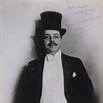
Serge Diaghilev
If you’re anything like me, seeing this fabulous show will take you at least two visits. It’s huge, covering two floors of the East Building of the National Gallery in Washington, DC. Devoted to the merging of art, choreography, dance, and original music that became the first modern ballet company: Serge Diaghilev’s Ballets Russes, this exhibition showcases more than 130 costumes, set designs, films, paintings, costume designs, posters, and other charming ephemera, including the earrings worn by Nijinsky in Scheherazade.
Diaghilev, with his peculiar brand of entrepreneurialism and artistic vision, comes fully alive here. We learn from the beautiful exhibition companion book, that in 1905, at 33, Diaghilev organized an exhibition of Russian historical portraits in the capital, St Petersburg. The tsar himself, Nicolas II, personally opened the display and enjoyed seeing his Romanov ancestors among the paintings Diaghilev secured by visiting great houses and cajoling the owners to lend them for the show. Diaghilev expected to be named minister of culture, at the very least, but events conspired against him, and after 1906 his entire career took place outside of Russia.

Costume from Coronation Scene, Boris Godunov, 1908
Yet Russia, its exoticism, spirit, and folktales are present everywhere here – if Diaghilev couldn’t celebrate his homeland in his homeland, he made it glitteringly accessible to Europe and beyond. At the opening of this show, we see a spectacular robe from the coronation scene of Boris Godunov (1908), a bell-shaped garment embroidered with silk and metal thread, glass beads, in what appears to be a pomegranate pattern, its orientalism setting the tone for what’s to come.
The exhibition is organized by ballet–Prince Igor, Les Sylphides, Petrushka, and Scherazade among them–each having its own section. The only known footage of a 1928 Diaghilev rehearsal of Les Sylphides plays next to the costumes and miniature set designed by Alexandre Benois. One of the innovations that Diaghilev and his collaborators brought to dance was liberating the torso from stiff stays to allow a more fluid line. Brilliant silks, flowing trousers, and Turkish-inspired tunics abound. You’d be stunning at any black tie affair decked out in one of Prince Igor’s Ikat coats. Charming pencil sketches by Valentine Hugo (1911) show Nijinsky in the title role of Petrushka while screening on a wall we see a performance of the same ballet by the Joffrey Company (1981).
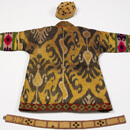
Costume, Prince Igor
Be warned: The costume sketches by Leon Bakst will cause lightheadedness, lust, and the desire to rip them from the walls. In fact, to call them “sketches” hardly does them justice. Dramatically posed, beautifully drawn and accented with vivid color and metallic paint, they’re works of art in themselves. We see the 1910 costume for the chief eunuch from Scherazade – he wears raspberry silk with paisley applique, a plumed turban and wonderfully striped trousers. An official-looking bunch of keys hangs from his belt. Bad news: you’re a eunuch. Good news: the clothes are great.
How can you not fall in love with Bakst’s Odalisque (1911)? She flips an orange scarf with abandon, wearing a see-through top, one shoe off, in transparent “harem” pants. Bakst traveled widely—to Greece, North Africa—and brought back ideas for costumes.

The Little God costume from “The Blue God”
Some little-known ballets are showcased here as well: The Blue God, a Fokine mash-up of Hindu and Buddhist images, was performed only six times. The “little god” costume with headdress of stacked heads, is particularly charming. Another gorgeous Bakst sketch for a Temple Dancer, Young Raja, and Pilgrim from The Blue God left me craving the shoes, pale green with turned up toes. A mannequin leaps, wearing a costume covered with rose petals from the The Rose. Nearby, we see a beguiling photograph of Nijinsky wearing the costume, as the Spirit of the Rose.
One of the many joys of this show are the paintings—Modigliani’s portrait of Leon Bakst (1917), with a blond moustache and twinkly blue eyes to match his scarf; a 1910 Jacques Emile Blanche painting of a costumed Nijinsky for The Oriental; and “Exit the Ballets Russes,” a 1914 cubist work by Fernand Leger.
A guaranteed swoon is the sloe-eyed Faun, Rudolph Nureyev, from the 1967 Joffrey Ballet performance of Afternoon of the Faun. Just under the screen are arrayed three of the nymph costumes you see the dancers wearing as they approach the pied

Costume, by Leon Bakst for Afternoon of the Faun
Faun. If you find yourself wishing you could watch the whole ballet enfold, you can content yourself with Bakst’s seductive sketch, featured as the signature image of the show.
The strident, insistent notes of Stravinsky’s Rite of Spring, along with the film of the Joffrey Ballet’s 1987 performance, strikes you: how extraordinarily avant-garde this work of art was in 1913. Chilling and brutally beautiful, one can see how much this work must have influenced modern dancers to come—Martha Graham and Erick Hawkins particularly. The costumes (by Nicolas

Costumes, Rite of Spring
Roerich) are displayed in a circle in the middle of the room. Painted silk and felted wool, you have to wonder how the dancers fared under the bright stage lights.
Perhaps the most poignant moment of the show’s first floor is coming upon a small crayon and pencil work, entitled “A Mask,” done by Vaslav Nijinsky after succumbing to schizophrenia. One of many similar works he did from 1918-1919 while being treated in a sanitarium, it conveys the feeling that the person behind the mask is imprisoned. Nijinsky never danced again.
Three dance performances accompany the show:
The Washington Ballet – June 9, 1:00 and 3:30
Kirov Academy of Ballet – July 13, 1:00 and 3:30
Dana Tai Soon Burgess Dance Company – August 11, 1:00 and 3:30
The show, in the National Gallery’s East Building, will be seen until September 2, 2013
http://www.nga.gov/content/ngaweb/exhibitions/2013/diaghilev.html

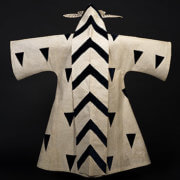
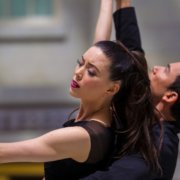
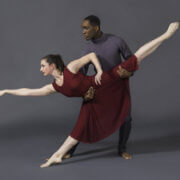
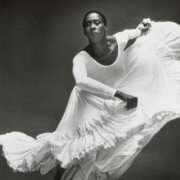

You make the show sound irresistible and I must get down to see it. By the way, in addition to fabulous clothes, eunuchs also enjoyed wealth and power. For some there may not be a down side!
Wealth and power and great clothes? Hmmmm…maybe you’re right!
I finally saw this exhibit for the first time this week, and, truly, you’re right, it’s overwhelming. It’s a visual feast for the eyes, ears, and mind, a well-thought out blend of art, music, dance, plus the visual impact of seeing the artifacts of the Diaghilev ballets — the costumes of Nijinsky, the wonderful peplums worn by the female dancers in Afternoon of a Faun, and the astounding backdrops, on the second floor, of Firebird and Le train belu by Picasso, which were so enormous it seemed the gallery was required to raise the roof. But I also enjoyed the wonderful costume worn by Lopokova in Les Sylphides, a name I had only congered in reading the life of John Maynard Keynes (who married her). The art and the artifacts were enormously helped by the visuals, the footage from the Joffrey and other companies that have recreated the dances. Rites of Spring, among them, was mesmerizing. Now I can understand the shock and awe the first outing inspired among the audience.
I think this exhibit is one of the best I’ve ever seen at the NGA, and we Washingtonians are so lucky to be able to see it. I don’t think it’s traveling anywhere else in this country.
The exhibit has been extended to October 6.
By the way, is it all possible for you to enable us to enlarge the great photos on your website? It would certainly enhance our reaction to your descriptions.
As always, Terry, your comments bring so much to the discussion. As to the photos, I’m still learning how to format these pages…I’ll try to enlarge them for my next posting. So glad you saw the show…I agree that it may be the finest show I’ve ever seen at the NGA, or anywhere.